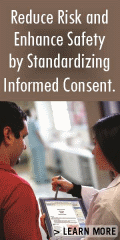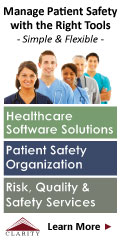 |
 |
 |

March / April 2005

Error Reduction
Stop The Noise
Reduce Errors by Creating a Quieter Hospital Environment

By Susan E. Mazer, MA
In the typical hospital environment, sounds of beepers, alarms, machines, telephones, and voices are considered "usual and customary" — normal to those who work there and those who watch the television show "ER." To patients, however, the sounds of the hospital are far from normal. Depending on a patient's age, hearing acuity, medication level, culture, and fears, these sounds may seem antagonistic, worsening a situation that is already difficult. Beyond difficult, however, prolonged exposure to environmental noise can increase anxiety and stress, ultimately impacting patient safety. But the good news is that it is possible to address the noise issue and create an environment for patients that is not only of better quality, but also inherently safer.
The Risks
Noise is a primary cause of sleep deprivation and disturbance among patients (Cmiel, et al., 2004). It increases their anxiety and decreases their confidence in the clinical competence of the staff, putting into question basic consideration on the part of the hospital in general. It contributes to patient falls, causes confusion, and results in increased medication and restraint use. Furthermore, noise-induced stress is contagious, impacting the attendant family member who may wind up at the nurses' station complaining about a variety of issues, each worsened by extraneous noise.
Sudden noises, such as a dropped tray or slammed door, may cause a "startle reflex" in patients, resulting in physiological responses such as facial grimacing, muscular flexion, increased blood pressure, higher respiratory rate, increased heart rate, and vaso-constriction (Cmiel, et. al, 2004). Patients exposed to continuous extraneous noise can also experience altered memory, increased agitation, less tolerance for pain, and feelings of isolation. These environmentally generated symptoms are often medicated or otherwise treated in ways unrelated to their cause.
People who work in noisy environments for long shifts, day in and day out, also have similar stress-induced experiences (Penny & Earl, 2004). They report everything from exhaustion to burnout, depression, and irritability expressed at home. Interfering and distracting sounds have been shown to contribute to medical and nursing errors. JCAHO mentions noise as a potential risk factor related to medical and nursing errors, stating that the ambient sound environments should not exceed the level that would prohibit clinicians from clearly understanding each other. An article in the Journal of the Association of Operating Room Nurses (November, 2003) reported a surgical episode in which the music was so loud that the surgeon's directions to the anesthesiologist regarding heparin levels were misunderstood by 8,000 units. Thus, beyond annoyance, within the sound environment lie potential safety risks that are often unidentified or ignored.
Improving Noise Levels
The EPA recommended guideline values for continuous background noise are 35 decibels during the day and 40 decibels at night in patient rooms. However, a review of the literature by Ulrich and Zimring (Center for Health Design, 2004) indicates that many studies have shown that noise levels in most hospitals are much higher. And, as Ulrich and Zimring point out, there are two general reasons why hospitals are excessively noisy. First, the noise sources are numerous and loud. They include paging systems, alarms, bedrails, telephones, staff voices, ice machines, pneumatic tubes, carts, and noises generated by roommates. Second, the surfaces in hospitals — floors, walls, and ceilings — usually are hard and reflect sound rather than absorb it. They cause sounds to echo, overlap, and linger.
A third reason why hospitals are noisy might also be that there are few effective behavior protocols in place to make staff aware of noise on a continual basis. Occasional awareness has been considered adequate when identified noises are ongoing and have direct impact on patient outcomes, as well as related costs. In defense of the staff, if the background noise level is high, then they will automatically speak louder to be heard and understood. However, it is also true that quiet begets quiet as much as noise begets noise. The sense of appropriateness in the dynamic sound environment has yet to be established.
The first step to reduce noise and improve the auditory environment is to set up and operationalize standards that are as stringent as all other environmental standards impacting patient safety.
While many hospitals are committed to creating a healing environment, the auditory environment, laced with noxious inappropriate noises, is often not addressed. A healing environment requires both a physical setting conducive to recovery in all aspects and an organizational culture that supports patients and families through the stresses imposed by illness, hospitalization, medical visits, the process of healing, and sometimes bereavement. The sound environment, which includes communications, monitoring, paging, and technologies, must also be managed in such detail that neither patients nor staff are at risk.
When we talk about managing the sound environment, it is with full acknowledgment of the fact that there is no "zero" noise measure. Silence does not exist, and noise is not an acoustic property. Rather it is a perception that is indefensible.
In its efforts to provide empirical standards and at the same time address the ambiguity of this issue, the EPA defines noise as "any sound that may produce an undesired physiological or psychological effect in an individual or group." This definition accompanies the decibel scale. What is clear here is that there are two tests, not one, to determine whether and to what degree noise is an issue. Based on the fact that noise is evaluated by patient satisfaction measures, the EPA verbal definition supersedes the decibel level standards as volume alone does not necessarily indicate noise.
Regardless of where the patient is, equipment dominates the current hospital experience. The heavily orchestrated environment includes multiple monitors, beepers, buzzers, paging, telephones, carts, wheelchairs and gurneys, hospital beds that are electric, pillow speakers, nurse call systems, IV poles that role on tiled floors, doors that close abruptly, and carts that squeak.
Solutions for Reducing
and Managing Noise
To minimize the potential for negative impacts of noise, standards or goals must be set to establish appropriate sound levels, including recommendations for modifying, maintaining, and purchasing equipment. In addition, repair and maintenance policies should be reviewed to respond to a higher quality of functionality that includes quieter operation. An auditory impact query should be part of every remodel, construction, piece of equipment, and staff event.
A recent study by Blomkvist et al. (in press, 2004) examined the effects of poor versus good sound levels and acoustics on coronary intensive-care patients in a large university hospital in Stockholm, Sweden, by periodically changing the ceiling tiles from sound-reflecting to sound-absorbing tiles. When the sound-absorbing ceiling tiles were in place, patients slept better, were less stressed (lower sympathetic arousal), and reported that nurses gave them better care.
Moving equipment and going from centralized nurse stations (where nurses tend to congregate and talk) to decentralized nurse stations can also help reduce noise. The Karmanos Cancer Institute in Detroit, Michigan, experienced a 30 percent reduction in medical errors on one unit after it installed acoustical panels and went to decentralized nurse stations. Methodist Hospital in Indianapolis, Indiana, attributes its improved medication error index on a redesigned coronary critical care unit to decentralized nursing and carpet in the hallways.
Judiciously using barriers, such as doors and curtains, to provide both visual and auditory protection will begin the process of controlling sounds that resonate from one area to another. Where visual access is appropriate, Plexiglas barriers can be effective. It is also well documented that single-bed patient rooms also are quieter than multi-bed rooms.
Replacing (or masking) noxious sounds with pleasant sounds moves the sound environment from being a challenge to a therapeutic modality. Enhancing the sound environment with music is a viable option if used appropriately, not in nursing stations where boom-box radios and CD players have been inappropriately broadcasting into hospital corridors.
As shown in other industries, foreground music can mask other irrelevant sounds and maintain an appropriate noise floor (i.e., the minimum noise level). In hospital settings, music combined with images of nature has been shown to reduce the amount of requested pain medication and/or improve its analgesic effect (Miller, et. al, 1992). In addition, when used appropriately, music acts as an effective audio-anxiolytic, improving restfulness and the quality of sleep, and inducing relaxation.
Another important step is staff education and new employee orientation to make staff aware of where they are and their accountability for maintaining an appropriate sound environment. While mandating staff behavior has long been known to be the least-effective method of managing noise, behavioral standards should nevertheless be modeled and extended organizationally. This is no different than instituting dress codes and mandatory practices for infection control. Sound control must be taken seriously. This includes standards governing private or confidential discussions that take place in public areas, the use and methods of paging, and use of cell phones, nurse call systems, and the telephone.
Finally, similar to all issues of patient and staff safety, it is important to measure and notice the noise intervention on a continuous basis. Using both quantitative and qualitative measures — decibel levels and patient satisfaction surveys — a comparative analysis can be made to determine what has been achieved and which aspects of the sound environment have yet to reach the established goals.
Susan E. Mazer is president of Healing HealthCare Systems (smazer@healinghealth.com), a Reno, Nevada, company that produces The C.A.R.E. Channel and other products and services that help healthcare organizations create healing environments to support the clinical process and patient recovery. She holds a bachelor of arts degree from Wayne State University and a master of arts degree from Stanford University.
References
Blomkvist, V., Eriksen, C. A., Theorell, T., Ulrich, R. S., & Rasmanis, G. (in press). Acoustics and psychosocial environment in coronary intensive care. Occupational and Environmental Medicine.
Cmiel, C. A., Karr, D. M., Gasser, D. M., Oliphant, L. M., & Neveau, A. J. (2004). Noise control: a nursing team's approach to sleep promotion. American Journal of Nursing 104(2), 40-48.
Miller, A. C., Hickman, L. C., Lemasters, G. K. (1992). A distraction technique for control of burn pain. Journal of Burn Care Rehabilitation 13(5), 576-80.
Penney, P. J., & Earl, C. E. (2004). Occupational noise and effects on blood pressure: Exploring the relationship of hypertension and noise exposure in workers. AAOHN Journal 52(11), 476-80.
Urlich, R., & Zimring, C. (2004) The role of the physical environment in the hospital of the 21st century. The Center for Health Design.

|
 |
 |
 |


















|
 |



